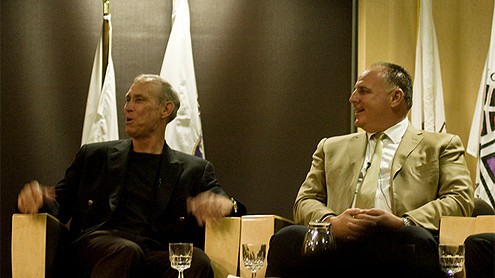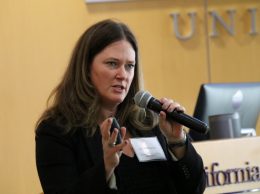Cal Lutheran remembers “Big Red Machine” manager

Alan Trammell, left, and Mike Scioscia in a lighter moment during a tribute to baseball legend Sparky Anderson. (photo by Joseph Peduto).
California Lutheran University honored the memory of Hall of Fame baseball manager Sparky Anderson Tuesday evening in a program full of baseball lore and warm stories about his ties to the university and the community of Thousand Oaks.
Former Detroit Tigers shortstop Alan Trammell, Angels manager Mike Scioscia and sportswriter David Lassen traded stories about the former manager of the Cincinnati Reds and the Tigers and assessed how he might have fared if he managed in more recent times, with outsized player contracts and “Money Ball” calculations in some front offices.
Anderson, the first manager to win World Series titles in both the National and American leagues, lived down the street from the university and was a strong supporter of the school and its athletic programs. University President Chris Kimball told the audience of about 180 that Cal Lutheran had wanted to honor Anderson shortly after his death in November of 2010, but his grieving family was not ready for a tribute until recently.
Proceeds from the event will benefit the CLU baseball program and CATCH, a charity founded by Anderson that supports pediatric patients at Children’s Hospital of Michigan and Henry Ford Hospital in Detroit.
Anderson managed the Reds to world championships in 1975 and 1976, when they were known as the Big Red Machine, with a heavy-hitting lineup including Johnny Bench, Joe Morgan, Tony Perez, Pete Rose and George Foster. After piloting the Reds for nine years, he took over a young Detroit team in 1979 and molded it into a unit that won a world title in 1984.
Trammell recalled that his manager of 17 years had more clout with the front office than seems apparent today and was able to get rid of players who didn’t fit in on the field or in the clubhouse.
Trammell said Anderson was not afraid to make unconventional moves, as when he made him his cleanup hitter after the team lost slugger Lance Parrish to free agency, even though Trammell was not known for his pop at the plate. As manager of the Reds, Anderson became known as “Captain Hook” for his frequent lifting of starting pitchers early in the game.
Scioscia said Anderson told him that a manager must be strong, but “he said your philosophy can’t be so overbearing that you try and make the team do what they’re not capable of doing.”
When the baseball players’ strike threatened the start of the 1995 season, Anderson was the only major league manager who refused to manage replacement players during spring training. He took an unpaid leave of absence, causing friction with Tigers management. During the question and answer session, the Business Times asked Trammell what his skipper had to say about that stance.
“Sparky had strong principles about not doing that,” Trammell said. “That kind of led to bad blood with the owner” and that season proved to be the manager’s last in baseball.
Lassen, a Riverside Press-Enterprise sports writer formerly with the Ventura County Star, said of Anderson, “Years after the fact, he was still adamant that it was the right decision and he had no regrets about it even though many believed it may have gotten him blackballed as a manager.”
On the question of “Money Ball,” Trammell and Scioscia were divided on how Anderson would react to it. Trammell thought his ex-manager would be more old school, although more involved with computers and video. Trammell said he thinks that scouts are still the backbone of an organization and that the A’s success had more to do with pitchers named Mulder, Zito and Hudson.
Scioscia said nobody was charting matchups while Anderson was managing the way they do now. “I guarantee you if you were in the dugout and he would say, ‘I don’t like this guy hitting against this pitcher,’ if you went back and looked at the stat records, there would be a reason for it. …What he knew in his heart and felt in a situation would correlate to some statistics that said this is the right decision.”
Trammell and Scioscia agreed that Anderson, a four-time Manager of the Year, could have thrived today in the era of mega contracts for elite players. “Absolutely,” Scioscia said. “Sparky’s talent was common sense. And the day that common sense doesn’t play, we’re in trouble. He absolutely would have been a manager for all ages.”
Lassen said he always thought it was appropriate that Detroit and Cincinnati were the places where Anderson managed. “He would have been a successful manager anywhere, but I think he wouldn’t have been as beloved as he was in those blue-collar, working-class towns where he ended up.”
Trammell said that for eight months of the year, the manager was known as Sparky, but back in Thousand Oaks, he was George, a common man in touch with the community.
Anderson’s biographer, Dan Ewald, sent a letter to the tribute that was read by university President Kimball. The letter and stories told by others at the tribute told how Anderson would walk the campus of CLU every day, that he knew all the members of the ground crew by first name and went out of the his way to say good morning to each one. He was proud of the university, Ewald wrote, and especially loved talking with young ballplayers. The baseball field on the campus is named after him.
Scioscia said Anderson grew up in Thousand Oaks and threw himself into the community, whether it be at the campus, golfing at Sunset Hills or joining others in the pews at St. Paschal Baylon Catholic Church.
“I think the lesson for all of us,” Scioscia said, “is that if you are not grounded in the community, especially in a high-profile position as manager or you’re a celebrity, that celebrity can take you and swallow you up.”











